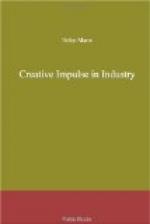As a human experience, the act of creating, the process of fabricating wealth, has been at different times as worthy of celebration as the possession of it. Before business enterprise and machine production discredited handwork, art for art’s sake, work for the love of work, were conceivable human emotions. But to-day, a Cezanne who paints pictures and leaves them in the field to perish is considered by the general run of people, in communities inured to modern industrial enterprise, as being not quite right in his head. Their estimate is of course more or less true. But such valuations are made without the help of creative inspiration, although the functioning of a product has its creative significance. The creative significance of a product in use, as well as an appreciation of the act of creating, would be evident if modern production of wealth, under the influence of business enterprise and machine technology, had not fairly well extinguished the appreciation and the joy of creative experience in countries where people have fallen under its influence so completely as in our own.
It is usual in economic considerations to credit the period of craftsmanship as a time in the evolution of wealth production that was rich in creative effort and opportunity for the individual worker. The craftsmanship period is valued in retrospect for its educative influence. There was opportunity then as there is not now for the worker to gain the valuable experience of initiating an idea and carrying the production of an article to its completion for use and sale in the market; there was the opportunity then also as there is not now, for the worker to gain a high degree of technique and a valuation of his workmanship. It is characteristic of workmanship that its primary consideration is serviceability or utility. The creative impulse and the creative effort may or may not express workmanship or take it into account. Workmanship in its consideration of serviceability oftentimes arrives at beauty and classic production, when creative impulse without the spirit of workmanship fails. The craftsmanship period deserves rank, but the high rank which is given it is due in part to its historical relation to the factory era which followed and crushed it. While craftsmanship represented expansive development in workmanship, it is not generally recognized that the Guild organization of the crafts developed modern business enterprise.[A] Business is concerned wholly with utility, and not like workmanship, with standards of production, except as those standards contain an increment of value in profits to the owners of wealth. It was during the Guild period that business came to value workmanship because it contained that increment. In spite of business interest, however, the standard of workmanship was set by skilled craftsmen, and their standards represented in a marked degree the market value of the goods produced by them.
[Footnote A: Thorstein Veblen; Instinct of Workmanship, pp. 211-212.]




